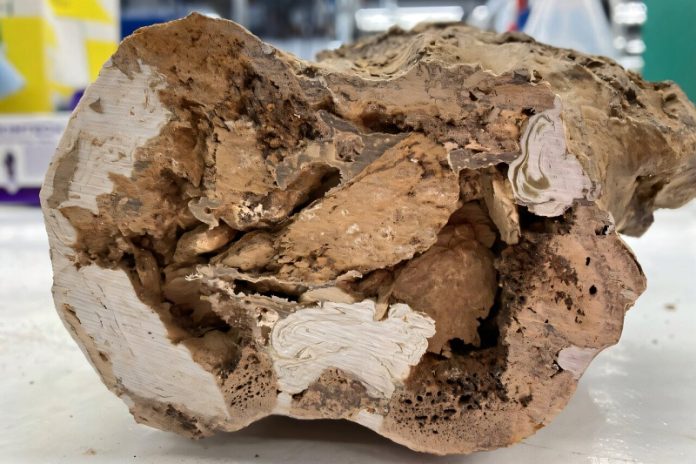
For many years, scientists believed that organic molecules could not survive in fossils, as the fossilization process was thought to destroy them completely.
However, a groundbreaking study led by the University of Liverpool has now found strong evidence that original organic material can still be present in dinosaur fossils.
Using advanced scientific techniques, researchers discovered preserved collagen in the hip bone of an Edmontosaurus, a duck-billed dinosaur that lived during the Cretaceous period.
This discovery helps settle a decades-long debate over whether organic materials can survive in fossils and opens new doors for studying ancient life.
The study, published in Analytical Chemistry, examined a 22-kilogram Edmontosaurus fossil from South Dakota’s Hell Creek Formation.
This fossil, housed at the University of Liverpool, was exceptionally well-preserved, making it an ideal candidate for testing.
Using mass spectrometry and protein sequencing, researchers found remnants of collagen, a protein that forms the structure of bones.
They also detected hydroxyproline, an amino acid that is specific to collagen in bones. This confirms that the collagen came from the dinosaur itself and was not a result of contamination.
Professor Steve Taylor, who led the study, explained the significance of the findings:
Refuting past beliefs – The study proves that some fossils do contain original organic molecules, challenging the old idea that fossilized bones are completely mineralized.
New research opportunities – Scientists can now revisit old fossil samples using modern techniques to see if they also contain preserved collagen or other organic materials.
Learning more about dinosaurs – Studying dinosaur proteins could reveal previously unknown connections between different species and offer new insights into their biology.
Solving a mystery – The discovery raises the question of how proteins like collagen have survived for millions of years and what conditions allow for their preservation.
The study involved experts from multiple universities and research centers:
- Scientists at the University of Liverpool conducted mass spectrometry and protein sequencing to confirm the presence of collagen.
- Researchers at UCLA used tandem mass spectrometry to detect and measure hydroxyproline, proving the collagen came from the dinosaur.
- The Materials Innovation Factory and the Centre for Proteome Research at the University of Liverpool provided additional imaging and sequencing to strengthen the findings.
This discovery could lead to a new era of fossil research, where scientists can study preserved proteins to better understand dinosaurs and their evolutionary history.
By applying these techniques to more fossils, researchers may unlock even more secrets about the ancient world.



